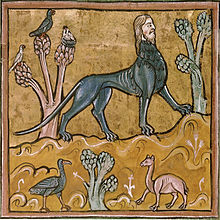The Unicorn, the Gorgon, and the Manticore
| The Unicorn, the Gorgon and the Manticore | |
|---|---|
| "Madrigal fable" by Gian Carlo Menotti | |
 The composer in 1944 | |
| Language | English |
| Premiere | October 19, 1956 Library of Congress, Washington D.C. |
The Unicorn, the Gorgon and the Manticore or The Three Sundays of a Poet is a "madrigal fable" for chorus, ten dancers and nine instruments with music and original
Background and performance history

The Unicorn, the Gorgon and the Manticore was commissioned in 1956 by the Elizabeth Sprague Coolidge Foundation for the 12th Festival of Chamber Music in
The world premiere took place at the Library of Congress
Structure and music
The Unicorn, the Gorgon and the Manticore consists of a prologue and 12 madrigals which tell a continuous story. They are sung (most of them
Synopsis
The prologue describes a strange man living in a castle above a seaside town who shuns the town's social life and the
Recordings
An
- Menotti: The Unicorn, the Gorgon and the Manticore – Boston Cecilia, Donald Teeters (conductor). Label: Newport Classic (1997)[6]
- Menotti: The Unicorn, the Gorgon and the Manticore – Carolina Chamber Chorale, Timothy Koch (conductor). Label: Albany Records (2001)
References
Notes
- ^ See for example, Teeters (1996); Ardoin (1985) pp. 111–112; Dyer (October 2, 1997); Time Magazine (November 5, 1956)
- ^ Hixon (2000) p. 8
- ^ Teeters (1996)
- ^ a b Time Magazine (November 5, 1956)
- ^ Hixon (2000) p. 283.
- ^ a b Dyer (October 2, 1997)
- ^ Banno (January 20, 2009)
- ^ The Esoterics: Gian Carlo Menotti centennial; Programme of The Ljubljana Festival 2011 (both accessed 25 July 2011)
- ^ Hixon (2000) p. 281
- ^ Heyman (1995) p. 496
- ^ Menotti, Gian Carlo. Text of the Twelfth Madrigal, The Unicorn, the Gorgon, and the Manticore reprinted in James Madison University (2009) p. 4
- ^ Hixon (2000) p. 287
Sources
- Ardoin, John (1985). The Stages of Menotti. Doubleday. ISBN 0-385-14938-7
- Banno, Joe (January 20, 2009). "Review: Cantate Chamber Singers and Bowen McCauley Dance". Washington Post
- Dyer, Richard (October 2, 1997). "Recording review: Menotti: The Unicorn, the Gorgon and the Manticore, Newport Classic". Boston Globe(subscription required)
- Heyman, Barbara B. (1995). Samuel Barber: The Composer and his Music (reprint). Oxford University Press. ISBN 0-19-509058-6
- Hixon, Donald L. (2000). Gian Carlo Menotti: A Bio-bibliography. Greenwood Publishing Group. ISBN 0-313-26139-3
- James Madison University (2009). Programme notes: Contemporary Music Festival, February 4-7, 2009
- Life Magazine (February 25, 1957). "Beasts in a Ballet", Vol. 42, No. 8, p. 66.
- Teeters, Donald (1996). Programme notes: "Menotti's The Unicorn, the Gorgon, and the Manticore" (performed by the Boston Cecilia, Sanders Theatre, Cambridge, Massachusetts, March 10, 1996). bostoncecilia.org
- Time Magazine (November 5, 1956). "Madrigal & Mime"
External links
- Programme notes and complete libretto from the New Mexico TechChamber Choir performance of The Unicorn, the Gorgon, and the Manticore in May 2003
